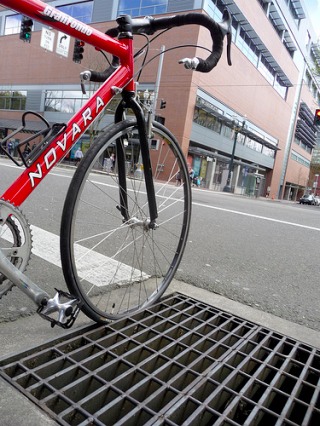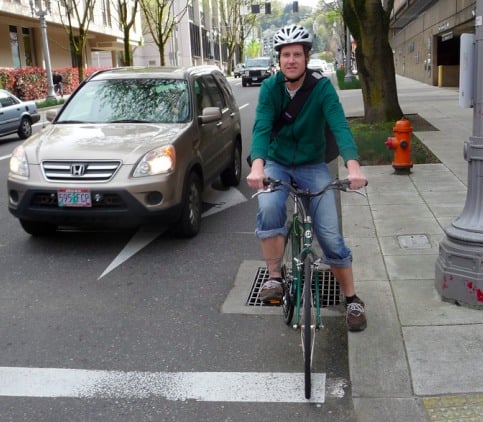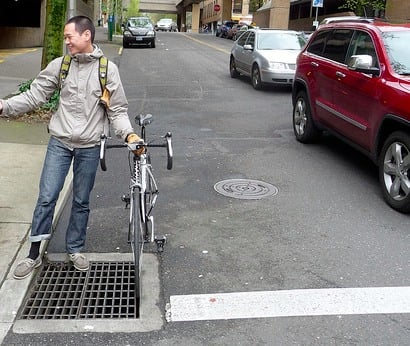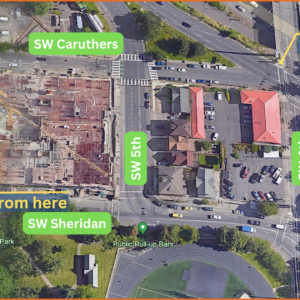
Portland is wider than a bike tire.
(Photos: Jim Parsons)
Super citizen activist Jim Parsons is at again. And this time, he’s mad about a bike-wheeling eating storm drain smack dab in the middle of downtown Portland and what he feels is a lack of action by the City to fix it.
Parsons has garnered quite a reputation for his tenacious, street-level activism that focuses on roadway hazards like overgrown vegetation (he carries pruning sheers in his panniers), potholes (he carries spray paint to mark them), and especially, storm drain grates (he’ll lift and turn them himself if possible so any gaps are perpendicular to traffic). (Learn more about him in our profile from a few years back.)
Last week, Jim found a prime example of a hazardous storm drain grate that, “could pose a bicycle safety hazard” on the southwest corner of SW 6th and Harrison (across from the PSU Bike Hub). Jim called the City’s 24-hour maintenance hotline (on speed-dial of course) and emailed a few contacts about it (along with a photo). “In this photo,” he wrote, “you can see my friend’s bike’s tire can easily slip inside the gap. If he had been riding when that happened, we can imagine the results.”
Jim says its a common problem he comes across: A grate that is too small for the opening it sits in and therefore a gap is created along one edge. As backup to his concerns, Jim cites Oregon Revised Statute 810.150 that states, “… storm drains… shall be designed and installed… with grates or covers so that bicycle traffic may pass over the drains safely and without obstruction or interference.”


After several days passed, Jim kept widening the CC list on his emails and continued to ask for answers. He eventually worked his way up to Kelly Shephard, the City of Portland’s Senior Public Works Supervisor.
Shephard left a voicemail for Jim about the issue; but it wasn’t the answer Jim was hoping for. In the voicemail, Shephard said the gaps are necessary and “designed” into the drains, “so that the workers can get them out.” Shephard added that his employees have experienced back injuries when debris clogs up in narrow gaps and makes the grates harder to remove.
“They have to be able to be removed when they need to be cleaned out, and without those gaps, they would not be able to remove them,” Shephard said in the voicemail.
Then Shephard suggested that people traveling by bike steer clear of the grates:
“I would encourage bicyclists to avoid catchbasin grates when they are riding… I would encourage bicyclists to ride over the middle of the grate as much as possible to avoid that edge…”
In a follow-up email, Shephard advised Jim to contact PBOT’s specifications manager if he’d like to pursue a formal change to the policy. “Please remember though,” Shepard added, “all proposed changes must take into account both worker and public safety.”
Here’s how Jim sees it:
“It’s my belief that larger gaps should be along the short end of the rectangle (perpendicular to traffic direction) to allow for the needed leverage for installation/removal. I also feel that a smaller gap is required for the longer edge of the rectangle (parallel to traffic). Is it really necessary for gaps as much as 7/8ths of an inch (parallel to traffic) to allow for removal and maintenance?”
This is an interesting issue. Is the way workers remove a storm drain grate more important than fixing what is clearly a safety hazard to road users? Does PBOT have places on the roadway where they’d advise people driving cars to avoid due to safety concerns?





Thanks for reading.
BikePortland has served this community with independent community journalism since 2005. We rely on subscriptions from readers like you to survive. Your financial support is vital in keeping this valuable resource alive and well.
Please subscribe today to strengthen and expand our work.
I notice on E Burnside (say between 47th and 67th) the storm drains sit down underneath the pavement and it creates a hole that would be unsafe to go over at a decent speed. Burnside is actually a nice wide street and okay to ride on when it is not rush hour because there is plenty of room for cars to go around, but I do need to go around those indentions and at rush hour, it can be quite hairy.
Why can’t the maintenance crews reach inside the grid with their hooks to pull them out?
…or build any other kind of tool to make it physically super easy to pop them out. Archimedes wrote some interesting stuff a while back on this thing called a lever.
That’s exactly what they do. The gap is so that the metal grate and metal frame that it sits in don’t wedge and rust together. Too much. The gap is not for inserting a tool. The grates are still sometimes very difficult to remove.
That said, this installation is an anomaly, or Jim would be notifying authorities about every grate having large gaps. The majority do not.
Why can’t I get Kelly Sheppard’s email? He mentioned that his attempts to email me have bounced.
For your consideration…
2011 Oregon Revised Statutes
§ 810.150¹
Drain construction
• compliance with bicycle safety requirements
• guidelines
(1) Street drains, sewer drains, storm drains and other similar openings in a roadbed over which traffic must pass that are in any portion of a public way, highway, road, street, footpath or bicycle trail that is available for use by bicycle traffic shall be designed and installed, including any modification of existing drains, with grates or covers so that bicycle traffic may pass over the drains safely and without obstruction or interference.
(2) The Department of Transportation shall adopt construction guidelines for the design of public ways in accordance with this section. Limitations on the applicability of the guidelines are established under ORS 801.030 (Exemptions from amendments to vehicle code). [1983 c.338 §159]
I’ve repeatedly asked for someone to show me the construction specs (guidelines) for these grates, and I’ve still yet to get a reply.
I don’t want to come across as not being concerned for the health and safety of our public employees, but if they’re getting injured removing these grates, doesn’t that mean that something is being done improperly? There must be tools to allow for safe removal of these things.
Seeing as how a pry bar was probably invented before anything else ever in the history of the world, there should be a way that “lift with your legs” doesn’t even need to enter the equation.
It would probably take ten minutes of drawing and half a day of fabrication to create a tool that can remove those and not jeopardize any workers.
Or one could take a page from the BES.
The (round cast iron) sewer lids/manhole covers don’t have a gap all the way round but a hole you stick a hook into.
Just use a crowbar with a large fulcrum would do the job just fine and I am pretty sure they own those things already.
http://www.newpig.com/us/grate-lifting-hook/TLS330
You can buy one from that website – its $69
Hasn’t anybody manufactured any of these yet?
Oops, I meant one of these…
“I would encourage bicyclists to avoid catchbasin grates when they are riding…”
This is a great idea! Let’s stop putting the bike lane in the gutter!
That’s the first good idea I’ve seen in this thread. So far, commenters are second-guessing someone else’s job, and ought to ride along with a public worker, bring any $69 dollar tool (or anything) they care to, and see how clever they feel after removing as many as 60 of these in a day.
I would encourage this as well. I would further encourage drivers to avoid dangerously passing, yelling at, honking at, or running over cyclists who choose to ride in a lane position that allows them to avoid catch basin grates…
Maybe people could just run bigger tires.
Are you going to put some 4×4 mud tires on your Prius so you can more effectively navigate the occasional pothole? Or would you be more likely to adjust your lane position to avoid potholes?
presuming you see the pothole in the first place.
Considering the audience here, I may be coming across as a devil’s advocate here, but here goes. Without graphics.
Think of the grate edge-on as a low and wide rectangle. Most of us picture removing the grate from its frame by lifting one side – rotating it up in the frame. With the curb edge of the grate potentially under the curb, the street edge parallel to traffic flow is the one that will be lifted. That’s the edge with the gap in the photos. In order for the grate to rotate, the frame must have clearance for the diagonal measurement of the wide flat rectangle of the grate. Without that rotational clearance, the only way to remove the grate is to lift it vertically in the frame until it is clear – leaning over the center of the grate to balance the load gives the potential for back strain.
A fix would be to keep the frame the same size but to make the street edge of the grate from a bar stock with something of an inverted right triangular cross section. The base of the triangle would be at the top, effectively filling the gap but would immediately clear the frame upon rotating upward. Hard to retrofit an entire city, but easy to do at manufacturing time. Probably patentable if it’s not already out there.
agreed.
The Germans, who love to use a dedicated machine for every task, use an Unimog with a knuckle boom and a special hook to lift their storm grates vertically. The point of all this over-engineering being to empty the catch basin which is attached below the grate and which also keeps vermin from exiting the sewer system through these grates.
Using the Pythagorean theorem, a grate with a 2″ x 24″ edge cross-section would need less than a 1/8″ gap to allow for tiltage. What are the actual cross-section dimensions of these grates?
if the gap was *perpendicular* to the direction of travel, instead of parallel, there would be no problem for cyclists.
@El Biciclero – I was heading out the door when I wrote that and didn’t trouble to run the numbers. Good call. I did look over a bunch of grates I passed while riding. Now I’m thinking it has to do with accumulated grit and debris in the gap and being able to shift it when lifting the grate. Other comments about removable fills make sense to me. Other options would be making the grates trapezoidal in cross section – saw some small cast ones out there today – or making the sides of the grate out of round stock.
Current design demonstratably doesn’t meet the statute. Sounds like Public Works doesn’t want to think about that.
Ooh! I like the trapezoidal cross-section idea. That would allow grate tops to fit tightly into their spaces with no gap. The danger there would be with grates that didn’t quite fit (due to the grit accumulation problem, or wrong sizing) sticking up above the rim of the drain mouth.
The real reason I suspect we have ill-fitting grates is that they are not manufactured to any exacting standards and there is a general range of grate sizes that are “approved” for use with any given size of drain. When a new grate is needed for any reason, one that is “close enough” likely gets dropped in and then forgotten about.
Brilliant, for the most part. It still has to be moved clear of the opening, and safety has, so far, equated that with lifting slightly and dragging, as opposed to lifting up and flipping and dropping. Bearing in mind that, especially in your suggestion, the grate needs to go in in the same orientation that it came out. The best practice currently is to keep it close to the ground, which means you have to bodily bear the weight of it. As far as busting it loose to start with, I think you’re onto something.
I’m sure the gap could be filled with some type of linear replaceable, recycled rubber strip.
Not all catch basin grates have this problem. The city’s public works supervisor could probably learn fairly easily, some of the reasons for this. Most likely, there are better catch basin/grate designs than this particular one.
A new grate with a beveled edge, especially if the catch basin opening had an edge that matched it, would probably allow the gap to be eliminated and allow the grate’s ability to be lifted, to not be affected by whatever road debris chanced to get jammed between grate and catch basin opening.
Easy fix: slip a shim in the crack to fill the void. When one needs the grate removed, remove the shim, then remove the grate. The shim could be resin or polymer so the tweekers wouldn’t steal it.
More photos…
http://www.flickr.com/photos/ufobike/sets/72157629847727073/
If you really want safe storm drains, let’s talk non-slip coatings. Bare steel is slicker than grease. (Unless it’s dry. (Which you may have noticed is NEVER. (bitter much?)))
Grate job on this story Jonathan.
Is this really a problem? I think you would have to try very hard while riding very slowly to get your tire to fall into that gap and catch. (Yes — I’m a full time cycle commuter for 30+ years. But this doesn’t strike me as a problem.)
Ok, let’s presume you’re right… Now how hard would it be to find someone who’s desperate enough to do exactly what you say, then claim liability for “injuries”. Probably would cost more for lawyers fees than for the fix.
Hard enough, apparently, Jim, because right now there’s no insurance scheme going on. It’s just you saying “Oh my God! What if?”
They got us there. I’m sure there is not possible way to design a system that is both safe for bikes and easy to open to help prevent injury.
I disagree… a couple of chains and a hydraulic jack eliminates any human lifting of wedged in grates.
I think that was sarcasm, Jim.
the problem is that they use those double-wide drainage grates in the bike lane in the first place. They are never at the same grade as the pavement and you don’t ever want to ride over one. When present, they make the effective width of many bike lanes (like on N Interstate) about 12″-18″. There’s no reason they can’t use a single wide drain or integrate the drainage inlet into the curb.
It is possible to design and install catch basin grates that can be safely ridden over on a bike. It’s possible to redo un-rideable catch basin grates with grates that are safe to ride with narrow road bike tires. It’s been done in Beaverton.
When this particular catch basin grate was installed, I suppose the gap managed to pass inspection because people in charge at the time may not have had an imperative to determine that all points of the grate meet a specification for use by bikes with road bike tires; assuming they had such a specification, which probably didn’t exist.
Now that the need to meet a particular specification is known, the mission is fairly simple: fix the grate so it meets the now known spec. Instead of throwing away this grate and others around that may have a similar problem, and replacing it with a newly designed grate and catch basin that properly mates with it to meet the new spec, a fairly simple, make-do repair could probably be improvised. Some ideas have already been suggested in comments above.
All the existing grate needs is a beveled spacer to fill the gap at pavement grade. If some kind of hard rubber stock like that is available…maybe strips of old car tires…have the crew pull the grate, drill some holes in the side of the grate, attach the rubber stock with stainless sheet metal screws, throw the grate back down on the catch basin and go on to the next job. Not a lot different than the weather stripping attached to the bottom of exterior doors to keep out the draft.
“The gap in this storm drain grate in downtown Portland is wider than a bike tire.”
Not MY bike tire! I sure wouldn’t go riding around Portland on tires skinny enough to fall into that little slot. But hey, if someone wants to go out of their way to take this on and make a difference, what the hell … more power to ’em.
so in accordance with the advice of the city I’ll be swerving into traffic whenever I see a storm grate coming up… or better yet, avoid the bike lane completely because they also don’t want you weaving in and out…
This appears to be an incredibly narrow gap on a select few grates. Is this a real problem that people are experiencing out there? I can’t remember the last time I felt threatened by a storm drain cover with the slats perpendicular to traffic. Aren’t there bigger fish to fry?
Not a catchbasin related crash I know, but…
“On Wednesday, attorneys for the couple announced that King County has agreed to pay $3.5 million for Totten’s care for the rest of his life.
A Navy veteran and endurance athlete, Totten was biking with friends down Novelty Hill Road, east of Redmond, on Sept. 4, 2006, when the front wheel of his bike dipped into a depression, abruptly stopping the bike and throwing him headfirst onto the pavement. He was 31.”
http://seattletimes.nwsource.com/html/localnews/2009066177_bikewreck16m.html
And your argument misses this point….
Oregon Revised Statute 810.150 that states, “… storm drains… shall be designed and installed… with grates or covers so that bicycle traffic may pass over the drains safely and without obstruction or interference.”
I think the point being made is that there are other serious issues on the road that are more likely to cause a crash than a few storm drains with tiny 1/2″ gaps (I don’t know the actual width, but it appears to be about 1/2″). Stormdrains protrude 18″ or so into the street and bike lanes are typically 5-6′ wide. Usually, there’s so much leaf litter I can’t ride that close to the curb anyway. I have more issues with tree litter than storm drain covers… Streetcar tracks leave a gap of about 2″ wide, yet those are allowed. Why worry about this?
What about the potholes that everyone hates – drivers and bicyclists alike? Instead of raising a fuss over miniscule stuff like this, we could pursue a cause that would unite all road users…
There are always issues that are more important than others. Point here, is that a modification of this grate that would eliminate a hazard is probably fairly simple and inexpensive if somebody with the authority to fix it were to accept some ideas and suggestions as to how to go about doing exactly that.
Knowing the cost would involve having some idea of what the modification would be.
And of course, eliminating a known hazard could save the city’s residents many thousands of dollars in lawsuit awards to someone injured, after having found themselves obliged to ride a line that takes their wheel directly into the space between the grate and catch basin opening.
I don’t particularly understand why the long side of those rectangular gaps in the grate are oriented parallel to traffic. Wouldn’t you rather roll over the more closely spaced slats you’d get by rotating the grate 90 degrees?
The reason why grates are oriented as they are is for hydraulic efficiency. Water flows into the storm basin better when it has a longer gap and fewer bars in its direction of flow. Some drainage grates have even been designed with curved bars to try to encourage flow.
Double wide grates are not installed on a whim. Engineers will calculate the volume of water based on surface area, slope, time of concentration, etc. to come up with the required grate size. Rather than going with a double grate, it may also be possible to space grates closer together along the road. This is dependent on the terrain, intersections, driveways, etc. Also, the components of a drainage system are expensive, so doubling up on manholes, grates, etc. adds to the expense of a road.
I’m not saying that it isn’t worth doing a better job of making certain cycists can use the system safely, I’m just responding to the question and pointing out that physics and cost are also considerations.
Non-issue for all…
If you’re the city, use a hook and/or lever to remove the grates. The excuse of having an “extra gap” for lifting is WEAK! Who the heck do you think we (the public) are, coming out with an excuse like that? I know who we’re not…We’re not idiots!
If you’re a cyclist on the city streets, I have to assume you are experienced enough to pro-actively avoid road hazards, of which this may qualify. If you can’t avoid a 7/8″ gap on the far side of a roadway, you may want to re-examine your mode of travel in the interest of safety.
For what it’s worth, I try to avoid road grates no matter where I encounter them. …They’re almost always located below road grade and account for an uncomfortable bump that I’d rather not endure, unless absolutely necessary.
Peace.
I think we should begin pestering the city to pave the roads with rubberized asphault so that there is some padding when these grates cause crashes.
It’s baffling to me that storm drains are an acknowledged bike safety hazard that cause cities to take action out of concern for liability… but somehow light rail/streetcar tracks are not?
When is a 2 inch wide gap not equal to a 2 inch gap?
Apparently some 2 two inch gaps are more equal than others.
I want a team of city workers/city police to form a safety convoy around me as ride my bike through the city.
Here’s better idea, just don’t ride into the gaps. If you do, well, Hello Mr Darwin…
I believe this is against ODOT law.
Oregon law prohibits dangerous street drains; Oregon Revised Statutes (ORS) 810.150 requires that storm drains be designed so that bicycles may pass over them in safety:
“810.150. Drain construction; compliance with bicycle safety requirements; guidelines.
(1) Street drains, sewer drains, storm drains and other similar openings in a roadbed over which traffic must pass that are in any portion of a public way, highway, road, street, footpath or bicycle trail that is available for use by bicycle traffic shall be designed and installed, including any modification of existing drains, with grates or covers so that bicycle traffic may pass over the drains safely and without obstruction or interference.
(2) The Department of Transportation shall adopt construction guidelines for the design of public ways in accordance with this section. Limitations on the applicability of the guidelines are established under ORS 801.030.
This seems more like a gap in safety with skinny tires in a non-velodrome environment combined with not paying attention…
That grate looks pretty safe to me. Check out the homemade grate over the catch basin in downtown Clatskanie, I went over my handlebar and bent my fork. Besides it was sunk down in about an 18 inch deep vortex of death from which there was no return. I’m surprised small cars aren’t lost in the sucker.
It would be great if all the grids were as complete as the one in the article, because this is a poor example of a bad grate, I could find you 20 that are much worse and so much more dangerous. REALLY! DON’T RIDE OVER THEM, but your example in the article looks like there’s a meter to go around safely it as well.
In the picture of the tire in the crack- it looks like it would be ok if he were to just bump it over a quarter inch or so to make the gap equal on both sides